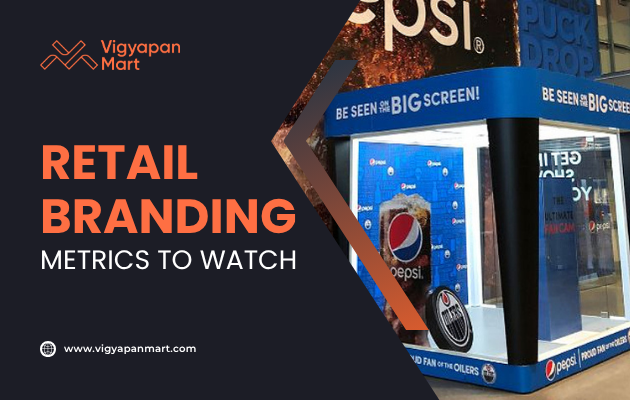Retail Branding ROI: Key Metrics to Watch for Success

Retail branding is a powerful tool that shapes customer perception, drives loyalty, and ultimately impacts the bottom line. However, measuring the return on investment (ROI) of branding efforts can be challenging. In this blog, we will explore how retail advertising can track their progress and optimize their strategies for the best results.
Why Retail Branding ROI Matters for Brands?
Retail branding goes beyond logos and slogans. It builds trust, differentiates businesses, and fosters customer loyalty. Measuring ROI helps brands fulfill their goals and deliver tangible results. Strong branding can lead to:
- Increased customer retention rates.
- Higher revenue growth.
- Enhanced brand reputation and equity.
Key Metrics to Measure Retail Branding ROI
To evaluate branding effectiveness, retailers should focus on three categories of metrics: perception, behaviour, and performance.
1. Perception Metrics
These metrics assess how customers perceive your brand and its relevance in the market.
- Brand Awareness: Measures how familiar customers are with your brand.
- Brand Preference: Tracks how often customers choose your brand over competitors.
- Customer Satisfaction: Evaluates overall satisfaction through surveys or Net Promoter Scores (NPS).
- Purchase Intent: Indicates how likely customers are to buy from your brand.
2. Behavior Metrics
Behavior metrics analyze actions taken by consumers based on their perception of your brand.
- Website Traffic: Tracks the number of unique visitors to your site monthly.
- Lead Generation: Measures how many leads are generated from branding campaigns.
- Customer Acquisition Cost (CAC): Calculates the cost of acquiring new customers.
- Social Media Engagement: Includes likes, shares, comments, and followers gained.
3. Performance Metrics
Performance metrics reflect the financial impact of branding initiatives.
How to Measure Branding ROI Effectively?
Step 1: Set Clear Benchmarks
Before launching a branding initiative, you need to build baseline metrics for awareness, traffic, sales leads, and profits. These benchmarks will help you to calculate an evaluation progress.
Step 2: Use Analytics Tools
You can use tools like Google Analytics for web traffic insights or CRM systems. These marketing automation platforms can provide you with detailed campaign analytics.
Step 3: Conduct Differential Analysis
You need to compare pre- and post-branding data on specific periods. This periodic analysis highlights areas of improvement and identifies gaps needing attention.
Real-Life Applications of Retail Branding
Retailers across industries have successfully measured branding ROI using these metrics:
Customer Loyalty
Studies show that 57% of consumers increase spending with brands they feel connected to. Tracking customer retention rates reveals the impact of branding on loyalty.
Revenue Per Visitor (RPV)
Retailers use RPV to understand overall marketing effectiveness by combining Average Order Value (AOV) with conversion rates.
In-store Metrics
Physical retailers track metrics like customer spend per visit and conversion rates to measure in-store experience ROI.
Challenges in Measuring Branding ROI
Despite its importance, measuring branding ROI has challenges:
- Intangible benefits like brand reputation are harder to quantify.
- Multi-channel campaigns require integrated data analysis.
- External factors like market trends can influence results.
To overcome these challenges, retailers should adopt systematic frameworks combining qualitative feedback with quantitative data.
Conclusion
Retail branding is an investment that pays off through increased customer loyalty, higher revenue, and improved market positioning. But how? All you need is identifying the best metrics for your business and monitoring them. These metrics can be perception, behavior, and performance indicators. By using these metrics, businesses can optimize their strategies and maximize returns on their branding efforts. Are you interested in knowing more about the outdoor advertising key metrics and how to measure them? Connect with the Vigyapan Mart experts today and find out all the secrets right away.









